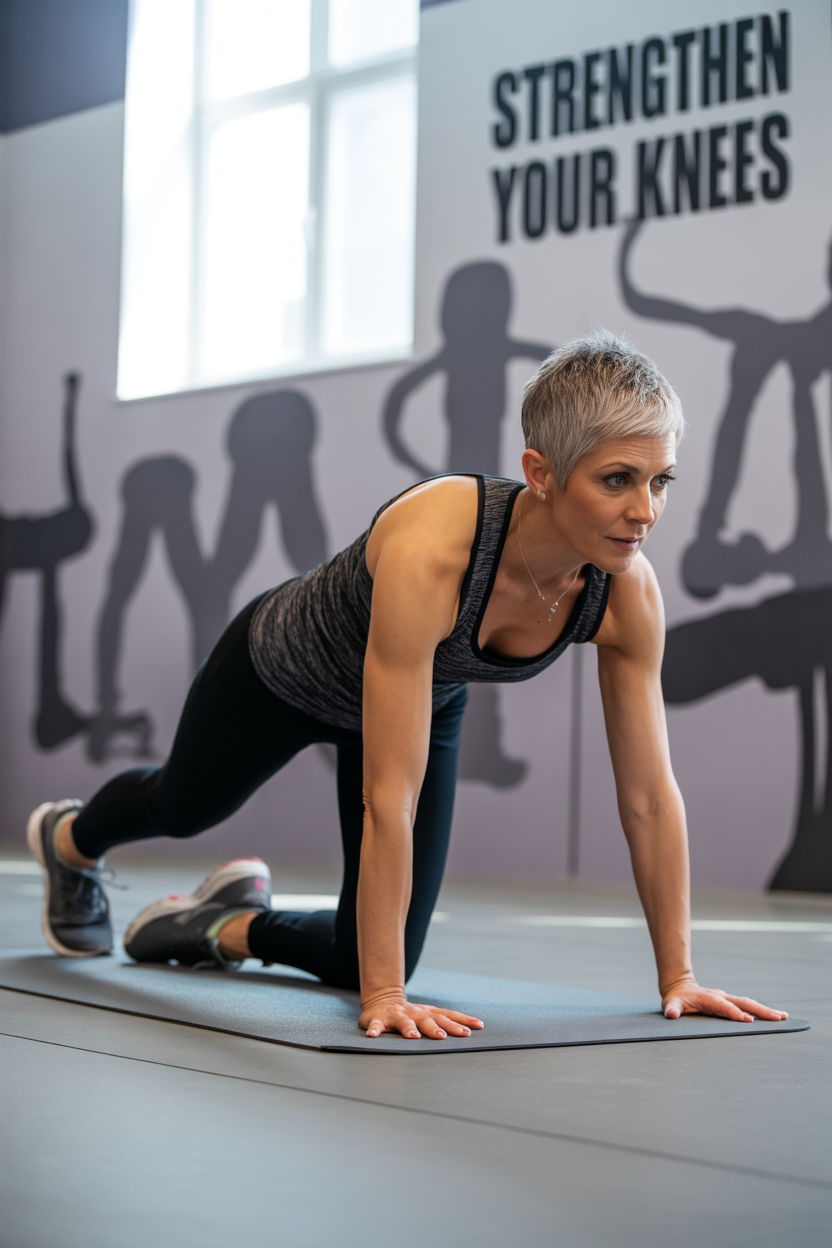How to Strengthen Your Knees: Essential Exercises for Women Over 60

Embrace Mobility: Gentle Exercises to Care for Your Knees After 60
From enjoying a walk in the park to chasing after your grandkids, our knees are the unsung heroes of an active life. As we grow older and wiser, our bodies might send us little reminders of their hard work, like a creak or an ache in a knee.
This is a completely normal part of our journey. The muscles that act as bodyguards for our knee joints can weaken over time. But there’s wonderful news: you can reawaken those supportive muscles with a gentle and consistent self-care routine.
Think of it as a new healthy habit that focuses on simple and effective knee exercises for women over 60. This practice gives your joints the care they need, helping you stay mobile and ready for all the day has to offer.
In fact, research shows that moderate-intensity exercise is not only safe but highly beneficial for older adults who experience knee discomfort. It’s a key part of maintaining your freedom of movement.
How to Prepare for a Safe Knee Workout
Before you begin any new fitness habit, setting yourself up for success is the most important step. This means preparing your muscles for movement and understanding the safety guidelines that will protect your body.
First, Chat With Your Doctor
It’s always a great idea to talk with your doctor or physical therapist before you start. Your body is unique, and they understand your personal health story.
They can give you a confident go-ahead and offer personalized wellness tips. This is especially important if you have a condition like arthritis or a previous injury. It’s a smart and necessary step to ensure you start out on the right foot.
Follow These Simple Safety Rules
Always have a sturdy chair, wall, or countertop nearby to hold for balance. Remember that slow, controlled movements are much safer and more effective. Safety should always be your top priority.
You want to feel a gentle warmth in your muscles, not a sharp pain. If you feel anything sharp, that’s your body’s signal to stop that specific movement. Don’t forget to wear good, supportive shoes to reduce extra stress on your knees.
Always Start with a Gentle Warm-Up
Taking a few minutes to warm up gets blood flowing and tells your joints, “Okay, team, let’s get ready to move!” Start by marching gently in place for a minute or two. Then, hold onto a chair and swing one leg forward and back 10 times, like a pendulum. Repeat on the other side.
Strengthen Your Thighs with a Seated Leg Lift
This simple move strengthens your quadriceps—the large muscles on the front of your thighs. When your quads are strong, they act like powerful shock absorbers for your knees. They help to support the joint and reduce discomfort.
To begin, sit tall in a sturdy chair with your feet flat on the floor. Keep your back straight and your core gently engaged.
Slowly and with full control, straighten your right leg out in front of you. It’s important not to lock the knee; keep a tiny, soft bend in it to protect the joint.
Hold this position for three to five seconds. You should feel the muscles on top of your thigh gently working.
With the same slow control, lower your foot back to the starting position. Aim to complete 10 repetitions on this side.
Once you finish with your right leg, repeat the entire sequence with your left leg, giving it the same focused attention.
Build Knee Stability Using a Wall Sit
Wall sits are a fantastic exercise for strengthening the key muscles that support your knees, including your thighs, hips, and glutes. This move works its magic without putting direct pressure on the joint itself.
Start by standing with your back flat against a wall. Your feet should be shoulder-width apart and about a foot away from the wall.
Slowly slide your back down the wall as if you are about to sit in a chair. A shallow “sit” is perfect! Only go as low as feels comfortable for you.
Look down at your knees. Make sure they are lined up directly over your ankles, not creeping out past your toes. This protects the joint.
Hold this “invisible chair” pose for 15 to 30 seconds. Feel the gentle burn in your thighs? That’s the feeling of building strength!
When you’re ready, slowly and carefully slide back up the wall to a standing position. Congratulate yourself on a job well done!
Improve Daily Moves with Functional Step-Ups
This exercise builds the strength you need for real-life activities like climbing stairs or stepping over a curb. As a bonus, it is fantastic for improving your balance.
Stand in front of a low, sturdy step or the bottom stair of a staircase. If you need extra support, hold onto a handrail or the back of a chair.
Begin by stepping up with your right foot, placing it securely on the step. Bring your left foot up to meet it, so you are standing fully on the step.
Now, carefully step back down with your right foot first, followed by your left foot, returning to the starting position on the floor.
Repeat this movement 10 times, always leading with your right foot. After 10 reps, switch it up and perform 10 more, this time leading with your left foot to make sure both legs get equal work.
Improve Balance to Help Prevent Falls
Good balance is your personal superpower against slips and falls, which can be especially tough on your knees. You can do this simple “Single Leg Stance” almost anywhere to improve your stability and boost your confidence.
Start by standing next to a wall or a sturdy countertop. Stand close enough to easily reach out for support if you need it.
Shift all of your weight onto one foot. When you feel stable, slowly lift your other foot an inch or two off the floor.
Find a spot on the wall in front of you to focus on. This will help you stay steady as you hold the pose for 20 to 30 seconds.
Slowly lower your foot back to the floor and then switch sides. As you get more confident, you can try holding on with just one finger, or even letting go for a second. You are always in control of your movement.
Release Hamstring Tension with a Seated Stretch
Your hamstrings are the large muscles along the back of your thighs. When they get tight, they can pull on the back of your knee and cause discomfort or limit your motion. A gentle stretch can offer wonderful relief.
To begin, scoot forward to the edge of a sturdy chair. This gives you room to extend your leg properly.
Extend your right leg straight out in front of you. Rest your heel on the floor and gently point your toes toward the ceiling.
Keeping your back straight, lean forward from your hips. Continue until you feel a light, comfortable stretch along the back of your thigh. There is no need to push or force it.
Hold this lovely stretch for 20 to 30 seconds. Remember to breathe deeply and avoid bouncing, which can strain the muscle.
Gently return to your seated position and then switch to your left leg. You should feel a sense of relief.
Support Your Knees by Stretching Your Calves
The muscles in your lower legs play a vital role in your body’s movement. Tight calf muscles can change the way you walk, which can put extra, unwanted strain on your knees. This simple stretch makes a big difference.
Stand facing a wall, about arm’s length away. Place both of your hands on the wall for balance.
Carefully step your right foot back, keeping that leg straight. Keep your right heel “glued” to the floor throughout the stretch.
Gently bend your front (left) knee as you lean into the wall. Continue until you feel a comfortable stretch in the calf of your back leg.
Hold this position for 20 to 30 seconds, breathing steadily. As with all stretches, be sure not to bounce.
Slowly release the stretch, and then switch legs to repeat on the other side. A consistent stretching practice will help your entire leg feel more mobile.
Add More Joyful, Low-Impact Activities
Adding other fun, low-impact activities to your weekly routine is a great way to care for your joints. These movements provide wonderful mobility without jarring or bumping, and are highly recommended for managing joint health.
A simple walk on a flat, even path is one of the best and most accessible things you can do for your overall wellness and knee health.
Try swimming or water aerobics. The natural buoyancy of water supports your body, so it feels like you’re exercising in a supportive cloud with zero pressure on your joints.
Consider using a stationary bike. It provides a smooth, circular motion that is fantastic for improving knee mobility in a safe, controlled way.
Explore practices like Tai Chi or gentle yoga. These are wonderful for improving your balance and flexibility through slow, graceful movements.
Common Mistakes to Avoid for Knee Safety
Being mindful of your form is the key to getting all the benefits from your workout. Pay attention to these common slip-ups to ensure your knees stay happy and safe.
One of the biggest mistakes is locking your knees. Always keep a tiny, soft bend in your knee joint, even when straightening your leg, to avoid hyperextension.
Avoid the temptation to rush. Remember that slow, focused, and controlled movement is safer and more effective for building strength.
Learn to tell the difference between muscle fatigue and joint pain. Feeling your muscles work is good; feeling a sharp pain in your knee is not. If it hurts, stop immediately.
Pay attention to your knee alignment. In moves like wall sits or step-ups, try to keep your knee tracking directly over your ankle and not letting it drift past your toes.
The “Ahhh” Moment: Your Essential Cool-Down
Just as a warm-up prepares your body for movement, a cool-down helps you transition back to rest. Taking a few minutes to cool down is a wonderful thank you to your hardworking muscles and joints.
After you complete your exercises, set aside five minutes to repeat the hamstring and calf stretches from your routine.
Holding these gentle stretches helps your muscles relax, release tension, and can prevent stiffness later on. It’s a simple act of kindness for your body.
Think of the cool-down as the perfect, calming end to your self-care session. It helps bring your heart rate down gradually and tells your body it’s time to repair and recover.
Create a Lasting Self-Care Practice for Happy Knees
The path to healthier knees is paved with small, consistent habits. By learning to listen to your body and creating a routine that works for you, you can enjoy lasting results and feel more confident in your movements.
Start by paying close attention to how your knees feel, not just during your routine, but the day after, too. It’s normal to feel like your muscles have worked, but you shouldn’t feel sharp pain in the joint itself.
If your knees feel achy, your body might be asking for a rest day. That is perfectly okay! Rest is when the magic of recovery and strengthening happens. Listening to your body is a key part of any safe exercise plan.
Remember that the little things you do every day add up. Wear comfortable, supportive shoes. When you lift something, bend with your powerful legs, not your back. Stay hydrated and eat a diet full of colorful fruits and vegetables to help your joints feel good from the inside out.






